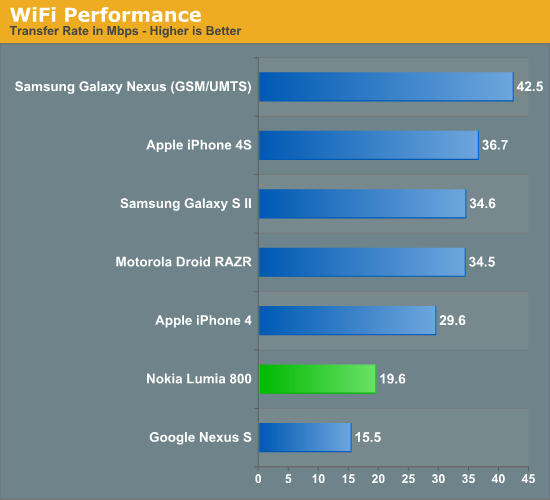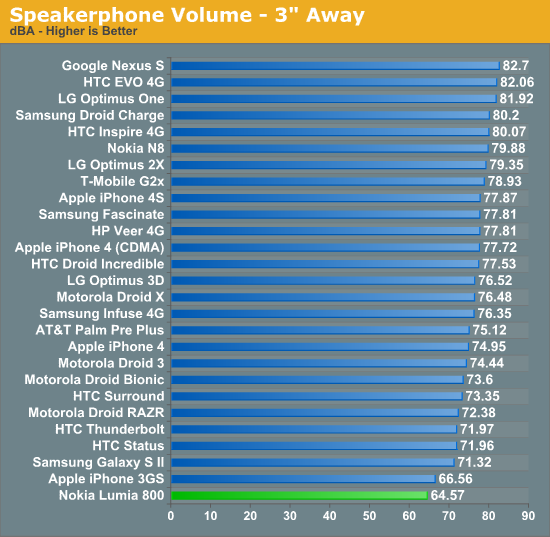Nokia Lumia 800 Review - Nokia's Brave New Foray into WP7
by Brian Klug on January 4, 2012 7:00 AM EST- Posted in
- Smartphones
- Nokia
- windows phone 7
- Mobile
- WP7
- Lumia
- Lumia 800
Cellular
Cellular on the Lumia 800 is supplied courtesy the MSM8255’s onboard baseband. Like all the Qualcomm S2 parts, this means GSM/EDGE/WCDMA with HSPA+. The Lumia 800 also takes a microSIM as noted earlier, and I tested on AT&T in my market. There are actually two Lumia 800 variants, each with different WCDMA bands - we were sampled the European variant which worked with AT&T’s PCS 1900 MHz WCDMA in my market. The Nokia Lumia 800 Specifications page is a bit misleading since it would have you believe that there’s only one variant with quad-band WCDMA when there are actually two different tri-band WCDMA devices.
| Nokia Lumia 800 - Network Support | |
| GSM/EDGE Support | 850 / 900 / 1800 / 1900 MHz |
| RM-801 (Europe) WCDMA Support | 900 / 1900 / 2100 MHz |
| RM-819 (USA) WCDMA Support | 850 / 1900 / 2100 MHz |
| Baseband Hardware | QCT MDM8255 w/QTR8200 |
| HSPA Speeds | HSDPA 14.4 (Cat.10) / HSUPA 5.76 (Cat.6) |
I couldn’t do my usual stats collection and histogram on the Lumia 800 since there’s no way to export that data from any of the speed test applications on Windows Phone. However, I did run some tests and see acceptable levels of throughput out of the device.
.jpg)
.jpg)
Some speedtests taken with BandWidth on WP7
WiFi
WiFi and Bluetooth 2.1 EDR on the Lumia 800 is supplied courtesy of a Broadcom BCM4329 combo chip which we’ve seen numerous times before in a number of different smartphones. Though newer devices are starting to ship BCM4330, I wager that WP7.5 includes drivers for just BCM4329 (which a huge majority of Windows Phones include) and BCM4325 (Venue Pro). On the Lumia 800, this means single spatial stream 802.11b/g/n connectivity only on the 2.4 GHz band.

Regardless, WiFi range on the Lumia 800 is totally par for the current generation of devices. In addition, WP7.5 continues to do a great job at deciding when to hand off and back onto WiFi when leaving the coverage radius of your house. It’s the small things like these that (to me at least) really demarcate the previous generation of smartphone OSes from the new breed. Unfortunately, in our throughput test which consists of loading a 100 MB PDF hosted locally on an 802.11n network, the Lumia 800 isn’t quite up to the speed of other BCM4329 devices. I’d wager this has more to do with the OS than anything else, though running network throughput applications on the Lumia 800 also gave a similar number to our normal PDF download test.
I should also note that WP7.5 also includes the ability to connect to WiFi APs that don’t broadcast their SSID. There’s a tab under Advanced in WiFi that now allows you to enter all that information and connect away, this wasn’t possible until Mango.
Speakerphone
In calls, the speakerphone on the Lumia 800 is honestly a bit too quiet, and our testing with a sound level data logger backs this up. Even at absolute maximum (where we test, of course) I found the sound level inadequate while using Nokia Drive or placing calls. It isn’t so much the position of the speaker at the bottom that’s a problem (in fact this is a good place to locate it), it’s just not loud enough.

Hopefully, this can be addressed with some software tweaking of the gains for speakerphone volume.
I also recorded some call quality test samples on the Lumia 800. The smartphone also does have the multiple microphone system for common mode noise rejection, though I'm not certain whose IP is being leveraged - perhaps Qualcomm's Fluence?
Noise rejection on the Lumia 800 is very good at all but the most extreme volume levels. Still, there are handsets that can completely reject the ambient noise that you hear at our maximum volume level. Unless you're in an absurdly loud environment, chances are the Lumia 800 will do a good job rejecting noise common between the two microphone system.
GPS
The Lumia 800 uses the GPS/GLONASS (GNSS) system onboard MSM8255 which we’ve seen numerous times before. Though WP7 doesn’t have API access to NMEA data so we can see SNR from individual satellites, the Lumia 800 does seem to get a GPS lock speedily enough even in some tough environments. In both the maps application and Nokia Drive I had no issues getting a GPS lock in under a 5 seconds keeping the lock for the duration of navigation.










120 Comments
View All Comments
Starfireaw11 - Wednesday, January 4, 2012 - link
For the most part, my Lumia 800 is fast, responsive and smooth. There are a few times where you do notice a bit of a slowdown, but certainly nothing worse than any other phone I've ever come across.A smartphone will always be a balancing act between power consumption, cost and performance, while maintaining a small form-factor. While a Xeon based smartphone would be possible, I don't see one being commercially successful for some reason :D
bplewis24 - Wednesday, January 4, 2012 - link
Android doesn't have bloated applications nor a bloated OS. Troll harder, or become informed as to what you actually speak of.N4g4rok - Wednesday, January 4, 2012 - link
My apologies, i should have specified.Over time, Android will slow down from fragmentation issues, like most OS's, but i've read more complaints recently about older versions of Android.
And unfortunately, due to poor coding, applications will occasionally succumb to memory leaks, further bogging down the OS. Of course killing the application will fix the problem.
It does not make Android inherently bad. It just makes the point that the OS would likely struggle on lower powered single core SoC's that some other phones have.
Penti - Wednesday, January 4, 2012 - link
Making core applications and libraries thread on a dual-core or quad-core SoC is just one way of speeding up some of the slower bits. But that's just a stop gap and just one way of doing it. You could just as easily do improvements for single-core SoC's there as well. Fragmentation actually helps overcome some of this. As the vendors put in improvements and eventually gets Google to redesign or implement new things. Just as you would get an actual NDK for WP at some point and can actually write and port normal applications to that platform. Which isn't trouble free. Which will hit limitations and which will fragment ones phone makers invest some into that platform. Nokia and ST-E will bring in none-Qualcomm hardware. They will bring in core alterations to the software and platform and eventually as it has already proven it will be hard to maintain everything.Just remember WP7 didn't even get sockets until Mango. Stuff like Spotify was ready for MeeGo at pretty much when Nokia released a device and released before Mango got it's client. Just because it got another model to paint stuff on the screen doesn't mean it is superior. Of course poor launchers can destroy a phone, but that is not where it's heading at with many of the vendors having already improved on that. Just look in another year and you will see a whole different market with dual-core being the standard platform driving WP. It took a year to even get basic applications on there... The development kit hasn't been proven as good as advertised by astroturfers. Nobody will make a business on a platform where you can sit and wait a year for even features 10 year old feature phones had.
N4g4rok - Wednesday, January 4, 2012 - link
I agree with that, and i do not mean to insist that WP7 is or will be superior to anything else.The options and large market share that Android offers makes it extremely attractive to multiple vendors, and on top of that, it's flexibility as a development platform is the icing on the cake. Combine that with Google's monitoring of software compatibilities and updating to suit, you end up with a solid, stable platform, just like their most recent releases are shaping up to be.
WP7 has neither of those qualities just yet. Although Microsoft may move in that direction with future releases,but they're taking their time to do it. Taking the time to ensure hardware compatibility is great, but like you mentioned, taking too long getting it up to speed will achieve nothing other than wasting a lot of time and money.
crispbp04 - Wednesday, January 4, 2012 - link
Look at the pot calling the kettle black.doubledeej - Thursday, January 5, 2012 - link
I've had two different top-of-the-line Android phones and they were both horribly slow and liked to stutter constantly. It was very annoying. I switched to WP7 and haven't looked back.steven75 - Wednesday, January 4, 2012 - link
"I've had the device for about a month now and I have to agree with everything that has been said in this article - I'm really happy with it and it's a huge improvement over the iOS,"Except the review doesn't say this. It basically points out that WP7 Mango is where iOS and Android were a year ago.
crispbp04 - Wednesday, January 4, 2012 - link
Weak editorial. I lol'd at "fledgling application ecosystem".Spivonious - Wednesday, January 4, 2012 - link
Yeah, aren't there like 200,000 apps now? All of the needed ones are there.I've been very impressed with WP7 Mango. The fact is that you don't need apps because lots of functionality is built in. People hub gets you Facebook, Twitter, LinkedIn, as well as standard contact info and links to send texts, IMs, emails, post on walls, etc. The Messaging hub combines texting, IM, and emails, grouped by the person you're conversing with. The Xbox hub places all of your games in one place. The Music+Video hub places all of your media and media-watching apps in one place. Bing Search combines web search, Sound Hound, Google Goggles, and Yelp.
And live tiles on the main screen let me see what I'm looking for without opening an app.
The strength of WP7 is the integration of services in one place. It's perfect for the average consumer.